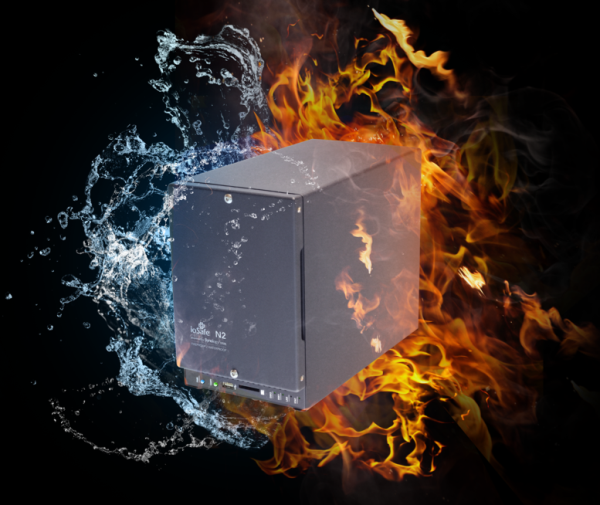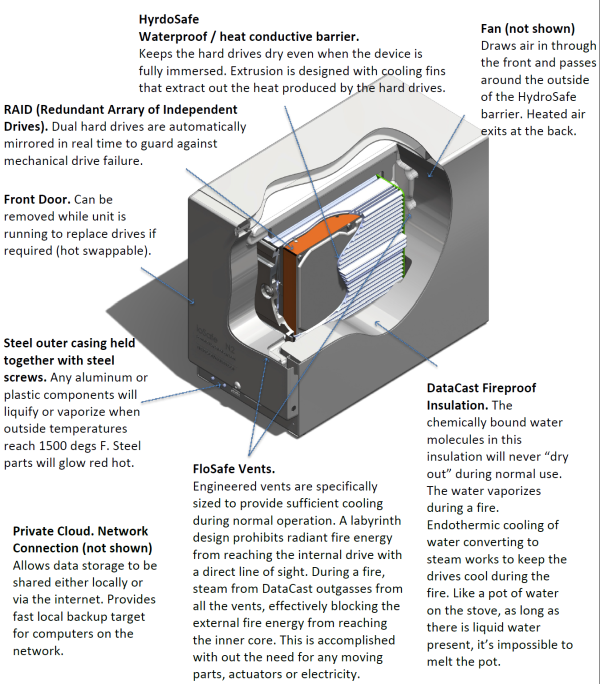ioSafe N2: A Disaster Proof NAS with Synology DSM
by Ganesh T S on September 18, 2012 11:50 AM EST- Posted in
- IT Computing
- Storage
- Synology
- ioSafe
ioSafe used to manufacture disaster proof NAS solutions / backup appliances such as the ioSafe R4. The R4s used to cost upwards of $10K, weighed more than 120 lbs. and the hard disks, though hot-swappable, needed a proprietary coating for waterproofing prior to usage. After taking a small break from the disaster-proof NAS market, ioSafe is back today with a new version, the ioSafe N2. It addresses all the shortcomings of the R4 by bringing down the weight to a more manageable 28 lbs. Hot swapping with standard hard drives is also supported, and the price for a diskless unit is a consumer friendly $599. Based on the Synology DSM (Disk Station Manager) firmware, the N2 is a 2-bay NAS unit with a 2 GHz Marvell CPU at the core along with 512 MB of DRAM. The performance, therefore, should be similar to that of the Synology DS213.
We had carried out a detailed analysis of ioSafe’s technology in our review of the SoloPRO earlier this year. The following picture shows the various aspects being used in the ioSafe N2.
A summary of the ioSafe N2 specifications is provided below:
Features:
- Local and Remote File Sharing: Between virtually any device from any location online
- Cloud Station: File syncing between multiple computers and N2 (like Dropbox)
- iTunes Server
- Surveillance Station: Video surveillance application
- Media Server: Stream videos and music
- Photo Sharing: Photo sharing with friends and family
- Mail Server: Email server
- VPN Server: Manage Virtual Private Network
- Download Station: Post files for others to download
- Audio Station: Stream audio to smartphone (iOS/Android)
- FTP Server: Remote file transfers
- Multi-platform compatibility with Mac/PC/MS Server/Linux
Hardware:
- Dual Redundant Disk, RAID 0/1, Up to 8TB (4TB x 2)
- 2GHz Marvel CPU and 512MB memory
- Gigabit Ethernet Port
- Additional ports for USB 3, SD Memory Card
- User replaceable drives
- Protects Data From Fire: DataCast Technology. 1550°F, 1/2 hr per ASTM E119 with no data loss.
- Protects Data From Flood: HydroSafe Technology. Full immersion, 10 ft. 3 days with no data loss.
- FloSafe Vent Technology: Active air cooling during normal operation. FloSafe Vents automatically block destructive heat during fire by water vaporization - no moving parts
- Physical theft protection (optional floor mount, door security - coming Q1 2013)
- Kensington® Lock Compatible
Support:
- 1 Year Data Recovery Service (DRS) Standard (upgrade up to 5 year)
- DRS included $2500/TB for forensic recovery costs for any reason if required
- 1 Year No-Hassle Warranty - Upgrades with DRS up to 5 years
Operating Environment:
- Operating: 0-35° C (95°F)
- Non-operating: 0-1550°F, 1/2 hr per ASTM E119
- Operating Humidity: 20% - 80% (non-condensing)
- Non-operating Humidity: 100%, Full water immersion, 10 feet, 3 days
Physical:
- Size: 5.9"W x 9.0"H x 11.5"L
- Weight: 28 lbs
ioSafe's CEO, Robb Moore, had responded to many of our questions and concerns in the comments section of our review of the ioSafe Solo PRO. Of particular relevance to today's piece is the 3-2-1 backup strategy advocated by ioSafe:
- Keep at least 3 complete copies of your data
- Keep them on at least 2 different devices
- 1 copy should be on taken offsite or disaster proofed in someway
Many consumers wish to have some sort of RAID-1 redundancy built into their backup strategy (We all know 'RAID is not backup'). For example, a disaster proof backup system could consist of a 2-bay NAS such as the Synology DS213 ($299), two 2TB drives (2x $100) and a 2TB SoloPRO ($370) costing $869 in total. Another way of implementing the 3-2-1 strategy would be an ioSafe N2 ($599), two 2TB drives ($200) and a generic 2TB external hard drive ($100) costing $900 in total. Both setups would give fireproof and waterproof backups with private cloud access, NAS and RAID. The second strategy does deliver a slight advantage:
- Post disaster, the user gets two chances to recover data from each drive.
- Drive failure doesn't result in losing fire/flood recovery ability
- Disaster-proofing the primary drives gives the user better recovery of the data that was in process moments before a natural disaster, giving an improved Recovery Point Objective (RPO). The SoloPRO in the first scenario might only have last nights backup depending on the user's settings.
- Getting to the disaster exposed drive is easier on the N2 because of the hot swappable nature of the drives and the lesser number of screws (Improved Recovery Time Objective (RTO))
The ioSafe N2 is being launched on Indiegogo today. General availability is scheduled for January 2013 with a retail price of $599.99 for the diskless version. Considering that ioSafe is a small company with 20-odd employees, crowdfunding initiatives like Indiegogo allow them to jump past typical startup funding models and rapidly accelerate the ioSafe N2 to market.
It is exciting to see ioSafe address the market for disaster proof network attached storage. This market is not necessarily as glamorous as the one that a recent crowdfunding hit managed to raise millions of dollars for. However, most consumers don't realize the value provided by solutions such as those provided by ioSafe until it is too late. With the final version of the ioSafe N2 already being demonstrated and the solid track record of ioSafe in the disaster proof storage market, we hope ioSafe is able to successfully reach out to the consumers through this initiative.


















15 Comments
View All Comments
psedog - Thursday, September 20, 2012 - link
iTunes can share it's library to other iTunes. This enables you to play music from another iTunes library. The Diskstation software emulates a shared iTunes library. Honestly, I don't find this useful for my home computers, but when a friend comes over it enables them to access my library without having to use up my computers resources.PEJUman - Tuesday, September 18, 2012 - link
My dad used to own a safe in the house, because most of his documents are physical.Most of my data is digital nowdays: family videos & pics, scans of documents (diploma, certs, transcripts). And I would hate to lose it all in a fire/flood/quake scenario.
I started to realize this is the new "house" safe, granted.. it does not replace the physical safe above (guns, ammo, actual docs), but today we would also require this solution in the house.
While cloud is gaining steam, Few issues still lingers with the cloud based backup:
-I still would like to have physical copies of my data, just in case those cloud company(ies) decided to go rouge/belly-up/pull a digital heist.
-Personally, I would not store any personal data in the cloud without an encrypted container (truecrypt comes into mind), which presents some logistical challenges on uploading one large container (few tens of gigabytes), to the cloud for every backup session.
-I have to rely on a secondary service to access it (internet provider), in a disaster scenario, it could be days before I can access any of my cloud stored data, while this device will run with laptop & generator/inverter.
Obviously all of the above scenario are extremes, but these are exactly where safes earn their keep. Although the price is steep, being an engineer myself, I still can appreciate the amount of effort required to do this and started to realize the asking price is not too bad.
Rob, if you're reading this, please don't take this the wrong way...
But I would like to know if the file structure are user accessible and whether the user can simply plug and play the removed drive into a plain window vista+ laptop to retrieve the data?
Obviously this is not the preferred method, but in case ioSafe "struggles" again, This would be the only failsafe to what otherwise would be a very expensive, burnt digital storage that remains inaccessible.
cdenesha - Monday, September 24, 2012 - link
PEJUman,You can learn this at www.synology.com, for example http://www.synology.com/support/faq_show.php?lang=...
chris
robb.moore - Thursday, October 4, 2012 - link
Hi PEJUman-Because this is a NAS with a Linux based file system, it's a bit more complicated than our external hard drive products. If our Solo series external drive goes through a fire, you'll need a simple USB HDD dock after extracting the raw drive from the carcass of the Solo.
For the NAS, you'll need a recovery core (Diskless N2) or a Synology NAS or a Linux machine to read the EXT4 file system.
Our devices come with a Data Recovery Service as well in which case we would work to recover the data for you and ship it back on a replacement system - all not cost to you if you're under the service plan.
Hope that answers your question. Thanks!
-Robb
edward1987 - Friday, November 4, 2016 - link
Iosafe waterproof synology is really great onsite backup. But in comparison with regular ds1515+ need to give up extra 1k. I guess its worth it to not loose sensitive data. Just strange that iosafe comes with 1year manufacturer warranty not 3 like Synology http://www.span.com/compare/DS1515+-vs-ND000-0/463...